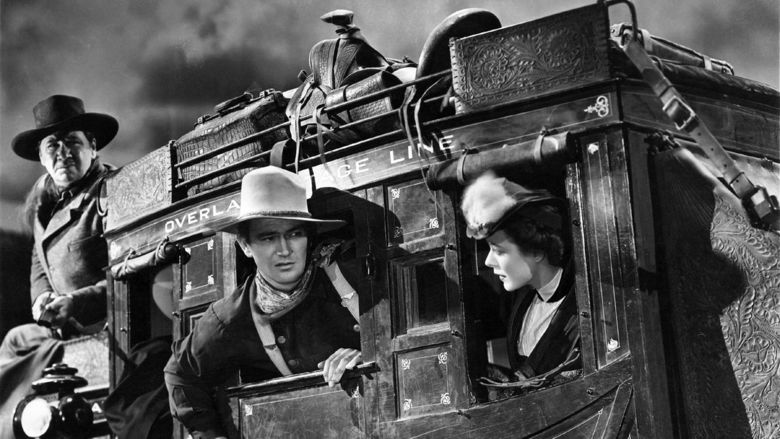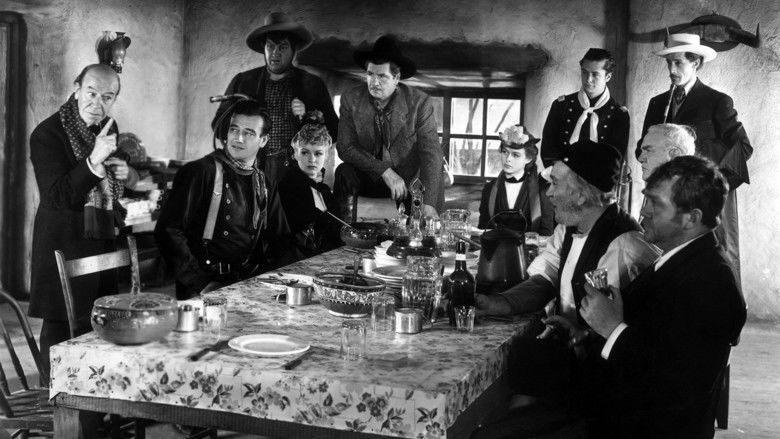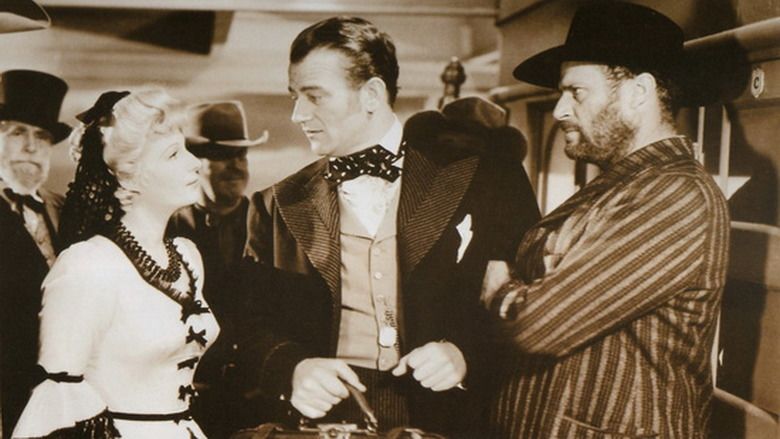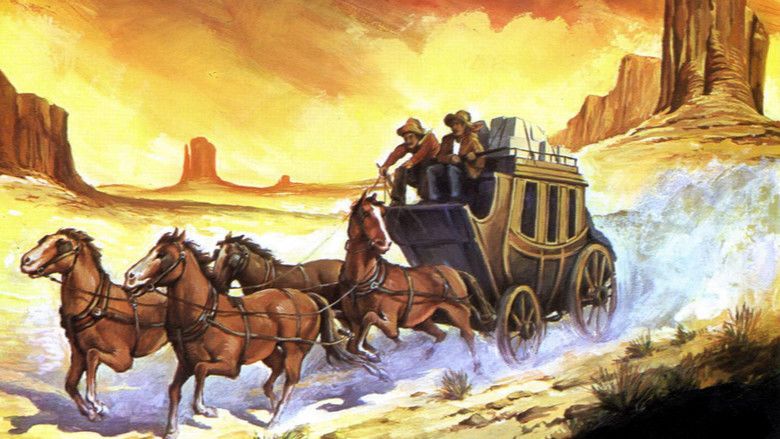Stagecoach (1939 film)
8 /10 1 Votes
Country United States | 8/10 IMDb Duration Language English | |||||||||||||||||||||||||||||||||
 | ||||||||||||||||||||||||||||||||||
Release date February 15, 1939 (1939-02-15) Initial release February 15, 1939 (Los Angeles) Cast (Dallas), (The Ringo Kid), (Buck), (Hatfield), (Doc Josiah Boone), (Lucy Mallory) Similar movies Blackhat , Ace in the Hole , Them! , Angel and the Badman , The Captive , The Night Crew Tagline John Ford’s smash hit and enduring | ||||||||||||||||||||||||||||||||||
Stagecoach 1939 theatrical trailer
Stagecoach is a 1939 American Western film directed by John Ford, starring Claire Trevor and John Wayne in his breakthrough role. The screenplay, written by Dudley Nichols, is an adaptation of "The Stage to Lordsburg", a 1937 short story by Ernest Haycox. The film follows a group of strangers riding on a stagecoach through dangerous Apache territory.
Contents
- Stagecoach 1939 theatrical trailer
- Plot
- Pre production
- Production
- Reception
- Academy Awards
- Others
- Re releases and restoration
- Radio
- Film
- Television
- Stagecoach 1939 official trailer john wayne john ford western movie hd
- References

Stagecoach was the first of many Westerns that Ford shot using Monument Valley, in the American Southwest on the Arizona–Utah border, as a location, many of which also starred John Wayne. Scenes from Stagecoach, including a famous sequence introducing John Wayne's character the Ringo Kid, blended shots of Monument Valley with shots filmed on the Iverson Movie Ranch in Chatsworth, California, RKO Encino Movie Ranch, and other locations. Similar geographic incongruencies are evident throughout the film, up to the closing scene of Ringo (Wayne) and Dallas (Trevor) departing Lordsburg, in southwestern New Mexico, by way of Monument Valley.

In 1995, this film was deemed "culturally, historically, or aesthetically significant" by the United States Library of Congress and selected for preservation in their National Film Registry.

Plot

In 1880, a motley group of strangers boards the east-bound stagecoach from Tonto, Arizona Territory to Lordsburg, New Mexico Territory. These travelers are unremarkable and ordinary at first glance. Among them are Dallas (Claire Trevor), a prostitute who is being driven out of town by the moralistic "Law and Order League"; an alcoholic doctor, Doc Boone (Thomas Mitchell); pregnant Lucy Mallory (Louise Platt), who is traveling to meet her cavalry officer husband; and whiskey salesman Samuel Peacock (Donald Meek).

When the stage driver, Buck (Andy Devine), looks for his normal shotgun guard, Marshal Curly Wilcox (George Bancroft) tells him that the guard is off searching for the fugitive Ringo Kid. Ringo broke out of prison after hearing that his father and brother had been murdered by Luke Plummer (Tom Tyler). Buck tells Curly that Plummer is in Lordsburg. Knowing that Ringo has vowed to avenge his father and brother, Curly decides to ride along as guard.

As the stage sets out, U.S. Cavalry Lieutenant Blanchard (Tim Holt) announces that Geronimo and his Apaches are on the warpath; his small troop will provide an escort to Dry Fork. At the edge of town, two more passengers flag down the stage and board: gambler and Southern gentleman Hatfield (John Carradine), and banker Henry Gatewood (Berton Churchill), who is absconding with $50,000 embezzled from his bank.

Further along the road, the stage comes across the Ringo Kid (John Wayne), whose horse went lame and left him afoot. Even though they are friends, Curly has no choice but to take Ringo into custody. As the trip progresses, Ringo takes a strong liking to Dallas. Doc Boone gets drunk on Peacock's samples. When Doc Boone tells Peacock that he served as a doctor in the Union Army during the "War of the Rebellion," Hatfield quickly uses a Southern term, the "War for the Southern Confederacy."
The stage reaches Dry Fork, but the expected cavalry detachment has gone to Apache Wells. Buck wants to turn back, but Curly demands that the group vote. With only Buck and Peacock objecting, they decide to proceed on to Apache Wells. At lunch before departing, the group is taken aback when Ringo invites Dallas to sit at the main table, and Mrs. Mallory is clearly uncomfortable having lunch with a prostitute. Hatfield gives Mrs. Mallory a drink from his silver folding cup, rather than have her drink from the canteen directly. She recognizes the family crest on the cup, and asks Hatfield whether he was ever in Virginia. He says he won the flask in a card game, but also that he served in the Confederate Army under her father's command. When the stage reaches Apache Wells, Mrs. Mallory learns that her husband had been wounded in battle and has left; she faints and goes into labor. Doc Boone has to sober up and deliver the baby, and later Dallas emerges holding a healthy baby girl. Later that night, Ringo asks Dallas to marry him, and live on a ranch he owns in Mexico. Afraid to reveal her checkered past, she does not answer immediately. The next morning, she accepts, if he will give up vengeance on the Plummers. He agrees. But she does not want to leave Mrs. Mallory and the new baby, so she tells him to go alone, and that she will meet him later. Encouraged, Ringo escapes - but then sees smoke signals heralding an Apache attack, and returns. The passengers quickly gather their belongings and leave.
The stage reaches Lee's Ferry, where Apaches have burned the station and ferry, and killed the station-keeper and his family. Curly uncuffs Ringo to help lash logs to the stagecoach and float it across the river. Just when they think that danger has passed, the Apaches attack. A long chase scene follows, with stunt work staged by Yakima Canutt. Peacock and Buck are hit, and the party all run out of ammunition. As Hatfield is about to use his last bullet to save Mrs. Mallory from being taken alive, he is mortally wounded. Just then, the 6th U.S. Cavalry rides up to rescue the stage.
The stage finally arrives in Lordsburg. Gatewood is arrested by the local sheriff, and Mrs. Mallory learns that her husband's wound is not serious. Peacock invites everyone to visit him in Kansas City. Mrs. Mallory thanks Dallas, who gives Mrs. Mallory her shawl. As he dies, Hatfield asks Mrs. Mallory to tell his family that he died bravely. Dallas begs Ringo not to confront the Plummers, but he is determined to settle matters. Curly lets him go (with a gun, but with just three bullets left after the Indian fight).
Luke Plummer, hearing that Ringo is in town, gets up from a poker game, leaving a hand of aces and eights. Plummer takes up a shotgun (an unfair weapon), but Doc Boone blocks his path, demanding that he leave it - or kill Doc first. Plummer leaves the shotgun, to Doc's relief, and joins his two brothers.
A shootout follows, which is heard but not seen. Ringo reappears, having killed the three Plummers, and surrenders to Curly, expecting to go back to prison. He asks Curly to take Dallas to his ranch. Ringo boards a wagon and says goodbye to Dallas, and Curly invites Dallas to ride with them to the edge of town. After she climbs aboard, Curly and Doc laugh and start the horses moving, letting Ringo "escape" with Dallas.
Pre-production
The screenplay is an adaptation by Dudley Nichols of "The Stage to Lordsburg," a short story by Ernest Haycox. The rights to "Lordsburg" were bought by John Ford soon after it was published in Collier's magazine on 10 April 1937. According to Thomas Schatz, Ford claimed that his inspiration in expanding Stagecoach beyond the bare-bones plot given in "The Stage to Lordsburg" was his familiarity with another short story, "Boule de Suif" by Guy de Maupassant. Schatz believes "this scarcely holds up to scrutiny" and argues that a more likely inspiration was Bret Harte's 1892 short story "The Outcasts of Poker Flat".
Ford's statement also seems to be the basis for the claim that Haycox himself relied upon Guy de Maupassant's story. However, there appears to be no concrete evidence for Haycox actually being familiar with the earlier story, especially as he was documented as going out of his way to avoid reading the work of others that might unconsciously influence his writing, and he focused his personal reading in the area of history.
Although Ford had made many Westerns in the silent film era, he had never previously directed a sound Western. Between 1929 and 1939, he directed films in almost every other genre, including Wee Willie Winkie (1937), starring Shirley Temple. Ford declined to use Wayne in any of his projects during the 1930s despite their close friendship, telling Wayne to wait until he was "ready" as an actor. In 1938, Ford gave Wayne a copy of the film's script by Nichols with a request to recommend an actor to play the Ringo Kid. After reading it, Wayne suggested Lloyd Nolan for the part, but Ford was non-committal to the idea. The next day however, Ford announced to Wayne that he wanted him to play the role. The offer left Wayne feeling as if he had been "hit in the belly with a baseball bat" ... and fearing that Ford would change his mind and hire Nolan instead.
Before production, John Ford shopped the project around to several Hollywood studios, all of which turned him down because big budget Westerns were out of vogue, and because Ford insisted on using John Wayne in a key role in the film. Wayne previously appeared in only one big-budget western, The Big Trail (1930, directed by Raoul Walsh), which was a huge box office flop. Between 1930–1939, by Wayne's own estimate, he appeared in about eighty "Poverty Row" westerns. Independent producer David O. Selznick finally agreed to produce the film, but was frustrated by Ford's indecision about when shooting would begin, and his own doubts over the casting. Ford withdrew the film from Selznick's company and approached independent producer Walter Wanger about the project. Wanger had the same reservations about producing an "A" western and even more about one starring John Wayne. Ford had not directed a western since the silent days, the most notable of which had been The Iron Horse (1924). Wanger said he would not risk his money unless Ford replaced John Wayne with Gary Cooper and brought in Marlene Dietrich to play Dallas.
Ford refused to budge; it would be Wayne or no one. Eventually they compromised, with Wanger putting up $250,000, a little more than half of what Ford had been seeking, and Ford would give top billing to Claire Trevor, a more well-known name than John Wayne in 1939. Following the film's release on March 2, 1939, Ford's faith in John Wayne was rewarded as the film met with immediate critical and trade paper success. Cast member Louise Platt, in a letter recounting the experience of the film's production, quoted Ford on saying of Wayne's future in film: "He'll be the biggest star ever because he is the perfect 'everyman'".
Production
The members of the production crew were billeted in Kayenta, in Northeastern Arizona, in an old CCC camp. Conditions were spartan, production hours long, and weather conditions at this 5700 foot elevation were extreme with constant strong winds and low temperatures. Nonetheless, director John Ford was satisfied with the crew's location work. For this location, filming took place near Goulding's Trading Post on the Utah border, about 25 miles from Kayenta. Western town scenes were filmed on the RKO Encino Movie Ranch, designed by Academy Award winner Art Director Max Ree.
Reception
Stagecoach has been lauded as one of the most influential films ever made. Orson Welles argued that it was a perfect textbook of film-making and claimed to have watched it more than 40 times in preparation for the making of Citizen Kane. The film made a profit of $297,690.
Academy Awards
Others
Re-releases and restoration
The film was originally released through United Artists, but under the terms of its seven-year-rights rule, the company surrendered distribution rights to producer Walter Wanger in 1946. Many independent companies were responsible for this film in the years since. The film's copyright (originally by Walter Wanger Productions) was renewed by 20th Century Fox, who produced a later 1966 remake of Stagecoach. The copyright has since been reassigned to Wanger Productions through the late producer's family under the Caidin Trust/Caidin Film Company, the ancillary rights holder. However, distribution rights are now held by Shout! Factory, which in 2014 acquired Jumer Productions/Westchester Films (which in turn had bought the Caidin Film holdings after the folding of former distributor Castle Hill Productions). Warner Bros. Pictures handles sales and additional distribution.
The original negative of Stagecoach was either lost or destroyed. John Wayne had one positive print that had never been through a projector gate. In 1970, he permitted it to be used to produce a new negative, and that is the film seen today at film festivals. UCLA fully restored the film in 1996 from surviving elements and premiered it on cable's American Movie Classics network. The previous DVD releases by Warner Home Video did not contain the restored print, but rather a video print held in the Castle Hill/Caidin Trust library. A digitally restored Blu-ray/DVD version was released in May 2010 via The Criterion Collection.
Radio
Film
Television
Stagecoach 1939 official trailer john wayne john ford western movie hd
References
Stagecoach (1939 film) WikipediaStagecoach (1939 film) IMDb Stagecoach (1939 film) themoviedb.org
